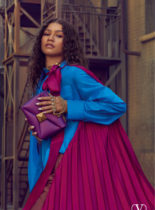- Words Colette Fountain
With brands like Coach and Valentino launching sustainability efforts this month, does designer going green mark a trend or a turning point?
Over the last decade, the fashion industry has undergone seemingly huge changes in its pursuit of sustainability. From the high street to high end, companies have tried to repair their image after the revelation that the industry is to blame for 8-10% of global emissions. One of the biggest challenges facing these companies is consumer attitude. An Oxfam survey found that one in eight Brits have over 300 items of clothing, while a report from Business of Fashion found that one in three women felt an outfit was old after it had been worn once or twice.
Despite apps like Vinted, Depop and Finds making efforts to change sentiments towards fast fashion and sustainability, it seems they might be fighting a losing battle, especially when pitched against influencers promoting a disgust for repeating outfits. However, research suggests there’s been a shift in the last few years with 60% of young people eager to stop buying fast fashion. It begs the question; what are luxury designers doing to meet the demand?
One of luxury fashion’s main initiatives in the last decade has been moving towards circular fashion. Vogue defines circular fashion as “a system in which all garments can be reused, recycled, or returned to the earth”, for example, by using biodegradable fabrics.
Circular fashion schemes have a surprising number of benefits. Not only do they help the environment, but they make high fashion more accessible, reviving vintage pieces and helping to save people money. They also encourage consumers to spend responsibly, rather than going on sprees worth several hundred pounds.
This month has seen some high fashion designers introducing resale initiatives in a bid towards improved sustainability, where consumers can buy directly through the brand. Coach recently introduced their (Re)Loved program: a scheme which restores and upcycles handbags at their repair workshop in return for credit worth up to £165. This is a great way for customers to access new collections while encouraging people to treasure their vintage bags and a more progressive consumer mindset.
Valentino Vintage started a similar scheme back in 2021, opening four stores worldwide, including a pop-up in Rellik, Notting Hill. The scheme allows customers to bring up to three pieces of Valentino to be evaluated and traded in for a store credit voucher, and is still running successfully into 2023.
So do these schemes have a positive impact? One of the main issues with sustainability in fashion is that it can be difficult to monitor. Despite internal investigations by fashion companies, and media exposés, sustainability seems impossible to police.
While sustainability is a positive move, the fashion industry seems to be failing in many ways. Whether it be through lying about ethical practices, questionable marketing campaigns, or accusations of sexual assault, there is a long way to go before designers regain the trust of consumers. The most powerful change we can make as consumers is shopping responsibly, as well as educating ourselves on the brands we consume. Brands will always be incentivised to improve if we show them exactly what we expect in return for our money, so shopping second-hand designer is certainly a nod in the right direction.


